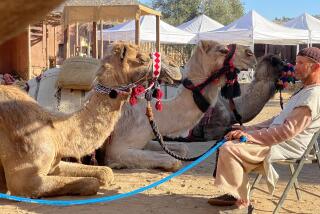Camel’s Milk Touted as Key to Ending Famine
- Share via
A British anthropologist who believes that the solution to Third World famine rests with the camel is spending the next two months teaching on Southern California university campuses and trying to find U.S. dollars for her $2-million “Camel Milk Project.”
It is estimated that milk produced by only one camel can keep 100 children alive, and that is the premise of the project ramrodded by Scarlett Epstein, a social scientist at the School of African and Asian Studies at the University of Sussex in England.
Epstein, a visiting lecturer at University of California campuses in Irvine and San Diego, is contacting a range of sources--from the U.S.A. for Africa project to the Rockefeller Foundation--in hopes of finding money for the project.
Cites Generosity
“The generosity of this country is well known,” she said. “It is recognized the world over that the United States is about the only country that one can look to for assistance in projects of this nature.”
Epstein and five other specialists from throughout the world will headline an international symposium on world hunger in Irvine next month to discuss a range of projects, from the use of sea water for crop irrigation to the establishment of a camel-breeding station in Africa.
The June 2 symposium, “Arid Lands Agriculture--the Solution to World Hunger,” is being organized by the Orange County Chapter of the American Associates of Ben-Gurion University of the Negev and sponsored by four Southern California universities.
Epstein believes that her project offers a long-term solution to hunger because it teaches starving people how to feed themselves. The proposal also offers some immediate relief for the hungry.
The project is built entirely around the camel, an animal long neglected as a possible solution to starvation in the desert, she said.
Traditional Problems
The low status of the camel herder, coupled with the animal’s poor rate of reproduction and high rate of calf mortality, has traditionally kept the camel from being considered as a food source for the masses, she said.
But Epstein said that research already developed, which combines new breeding techniques with the use of hormones to increase milk production by as much as 40%, will solve the problems.
“My task, as a social scientist, is to teach tribes that have had camels for generations to understand what must be done . . . and to convince tribes with cattle that they must switch to camels,” she said.
“That cultural phenomena will have to be treated very carefully. But then, people are more amenable to change when it is a life-or-death situation, are they not?”
Kenya Site Planned
The new techniques would be taught and practiced initially from a central camel-breeding station that should, ideally, be established in Kenya.
Epstein believes that the pilot project would be so successful that others would follow.
“We would teach these people how to be self-sufficient and how not to starve,” she said. “The idea is to hand over the running of the station to the people in three years.”
Although development of the station is the project’s primary and long-term thrust, it is only the final phase.
Initially, the people must be taught to milk the camels they have. And camels available throughout the world must be identified, bought up by the project and relocated to the areas in most immediate need.
No Firm Commitment
Although Epstein already has received “a positive reaction” to the project in Kenya, she has no firm commitment for financing.
She has approached sources in one country outside the United States, but found them unwilling to provide money until the hungry are able to carry out the project themselves.
More to Read
Sign up for Essential California
The most important California stories and recommendations in your inbox every morning.
You may occasionally receive promotional content from the Los Angeles Times.










